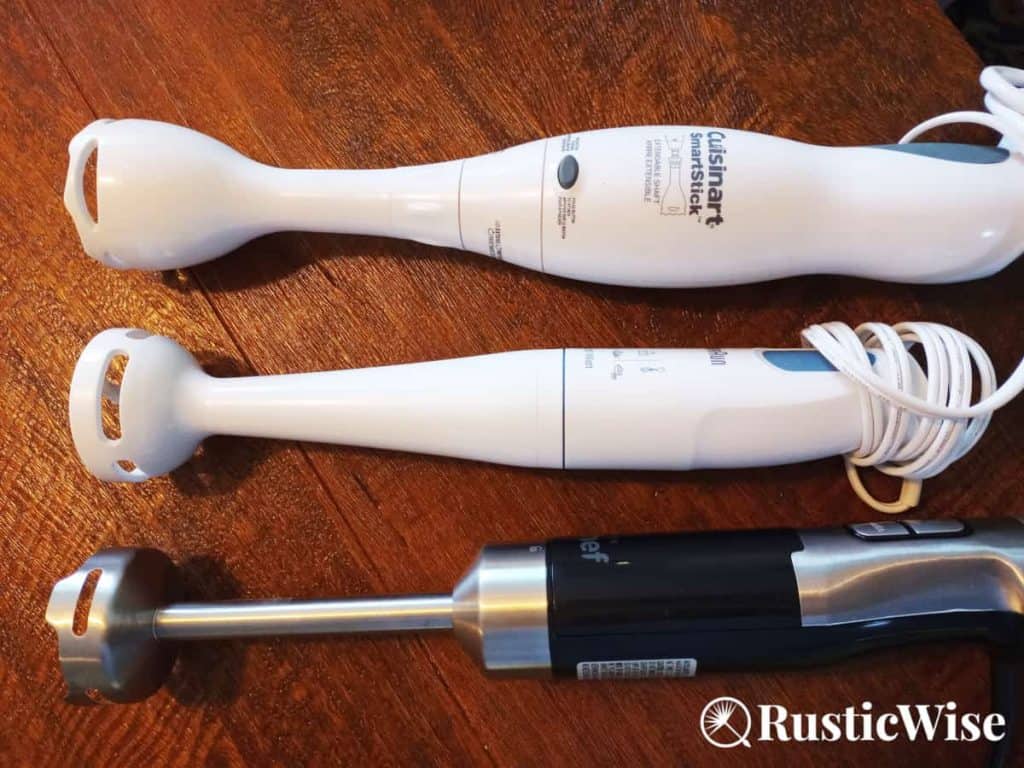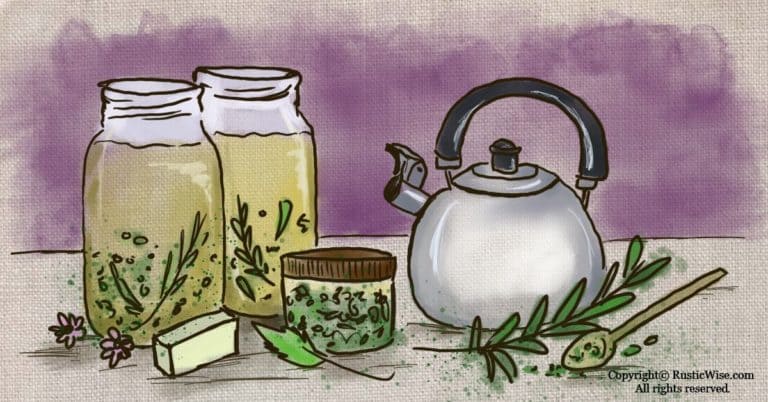Best Stick Blender for Soap Making: 9 Features To Look For
RusticWise is supported by its readers. When you purchase through links on our site, we may earn an affiliate commission. As an Amazon Associate, we earn from qualifying purchases. Thank You!
If you want to emulsify your soaping oils and lye solution without spending hours stirring by hand, you’ll need a stick blender for soap making. Also known as an immersion blender, wand blender, or hand blender, these handy tools are a game changer. Let me repeat: Game. Changer.
While you can still make soap without using an immersion blender, you’ll need to use a whisk or spatula to hand mix soap batter for hours. And, time is not something most of us have an excess of these days.
A handheld blender can bring soap batter to trace in a matter of minutes, rather than hours. And that’s something we can all get behind, right?
With all the different models on the market, it’s hard to sift through the junk to find the best stick blender for soap making. The great news is that you don’t need to spend a fortune on finding a reliable tool. We’ve compiled a list of key features to look for when shopping for your own blender.
Why you should use an immersion blender for soap making
Many of you might wonder, do you really need to buy a stick blender? Technically, you can still make homemade soap from scratch without one…it’s just that the job is so much harder and time-consuming without one!
If you have a hand-held blender, or a stand mixer, these aren’t the same as a wand blender.
An immersion/wand blender purees liquids (or soap batter), while the stainless steel whisk or paddles on a kitchen hand-held blender mix dry or semi-dry ingredients.
A regular stand mixer or a hand-held mixer are also more prone to splattering (which is dangerous when working with lye!), and may introduce more air bubbles.
Tip: Save your stand mixer for making DIY body creams or lotions instead of making soap!

Credit: RusticWise
Best stick blender for soap making: features to look for
Everyone has a different must-have list of features when shopping for a new soap blender. Here’s a list of features we feel are important—take ’em or leave ’em, but more knowledge is better. Here are ___ features to look for (in no particular order).
1. Material of shaft (and other parts that come in contact with lye)
When working with sodium hydroxide lye to make soap from scratch, it’s important to select a blender that’s made of a non-reactive material. In most cases, this is stainless steel.
Beware of any parts of the seals and bell that are made of aluminum—this type of metal reacts strongly when in contact with lye!
Tip: Look for blenders with a 100 percent stainless steel blade, shaft, bell, and seals made of non-reactive materials.
Can you use a plastic stick blender for soap?
To a certain degree plastic will do, but it doesn’t stand up to the rigors of soap making like stainless steel. If you’re making hot process soap, the temperature of the soap batter can get very hot—hot enough to warp or melt a plastic shaft.
If you’re making cold process soap, a plastic stick blender could work. Just know that the longevity of a plastic shaft may deteriorate more quickly than a pure stainless steel one.
You might like
Hamilton Beach 59765 Immersion Hand Blender with Blending Wand, Whisk and 3-Cup Food Chopping Bowl, Stainless Steel
- Simple Cleanup: Hand Mixer’s Blending Wand, Whisk and Chopping Bowl Attachments Are Dishwasher Safe.
- 225 Watt Motor: Powerful Enough for All Your Blending, Mixing and Chopping Needs.
- One Tool Does It All: Immersion Blender Lets You Blend, Mix, Whip, Puree and Chop With One 2-Speed Kitchen Multi-Tool.
Found on Amazon
Check Current Price
Those in Canada and the UK should be taken to the product listing in your region.
2. The bell curve
The shape of the bell surprisingly makes a difference in the amount of air bubbles you’ll need to release or burp out from the batter.
Bells come in all shapes and sizes. Look for models with a shallow bell that are less likely to trap air bubbles. Larger, rounder, or deeper bells are notorious for being air bubble traps!
Some bells have generous vertical vents or slits that contribute to fewer air bubbles in your soap batter.
3. Ergonomic design
A comfortable handle, intuitive buttons, and overall size are important considerations when looking for an immersion hand blender.
First, a soft grip and ergonomic handle will ensure that you don’t lose your grip on the blender while you’re mixing soap batter.
Next, you’ll want buttons that are within easy reach, so that you don’t accidentally press any by accident. The buttons and controls should be easy to read and understand.
Finally, you’ll want to make sure you find a blender that’s well-proportioned to your preferences. The overall dimensions of the blender should be compact and fit in most standard cupboards.
You might like
Braun MultiQuick 5 Immersion Hand Blender, Dual Speed, Powerful 350 Watt
- Power bell technology: Durable stainless steel blades and unique bell-shaped blending shaft for fast and finer results.
- Easy click ensures all attachments can be removed with one simple click.
- Soft grip handle for comfortable use and 20 ounce beaker and whisk attachment included.
Found on Amazon
Check Current Price
Those in Canada and the UK should be taken to the product listing in your region.
4. Detachable shaft
Having the ability to remove the shaft easily from the motor is a must-have, in my opinion. Look for a detachable shaft for easy cleanup. Bonus points if it’s dishwasher safe.
5. Multi-speed options
While it’s unnecessary to have dozens of speed options, it’s nice to have more than one speed to choose from. When mixing soap, you’ll find pulsing the batter for short periods of time helpful.
You might like
KitchenAid KHBV53ER Variable Speed Corded Hand Blender, Empire Red
- Removable 8-inch Blending Arm with a 4-point Stainless Steel blade design efficiently blends ingredients.
- Variable speed trigger switch for greater flexibility and control over recipes.
- US patent-pending removable pan guard to help protect your cookware.
Found on Amazon
Check Current Price
Those in Canada and the UK should be taken to the product listing in your region.
6. Motor strength
If you don’t want your hand blender pooping out after a few seconds, look for a model with a fairly powerful motor, one that’s at least 200 watts or more.
Less powerful motors are less efficient and overheat quickly. Motors that are constantly overworked will break down faster.
7. Extra attachments
While not necessary, you may find it useful to buy sets with nice-to-have extras such as a different shaped bell, blade, or whisk attachment. Many blender sets also come with a measuring cup.
You might like
Breville BSB510XL Control Grip Immersion Blender, Stainless Steel, Adjustable Speed
- Bell shaped base, revolutionary shape plus internal ribbing reduces the suction for greater control and efficient blending.
- 8-inch immersion depth for large quantities or tall pots.
- Non-scratch base to prevent scratching pots.
Found on Amazon
Check Current Price
Those in Canada and the UK should be taken to the product listing in your region.
8. Price
If you’re on a tight budget, the good news is that you don’t need to spend wads of cash on a top-of-the-line model. You can find many reliable models at a reasonable price.
There’s a wide variety of blenders with the more expensive models having a more sophisticated design with more bells and whistles. (Whether you actually need all the bells and whistles is up to you.)
9. Warranty
If you’re the sort of person who enjoys having peace of mind, an extended warranty is something you’ll want to have. Many models offer a warranty period of 1 year. Some pricier models offer longer warranties.
The choice is completely up to you whether you care about purchasing a blender with a warranty. (If you don’t have a decent warranty, you can always stock up on several inexpensive stick blenders in case your main one breaks down.)
A really annoying feature you’ll want to avoid
Some models (such as newer Cuisinart stick blenders) have a safety lock feature. This means you have to continually press down the lock/unlock button while simultaneously holding the on/off button. This is not exactly easy when you’re working with hot soap batter.
You might like
Chefman Immersion Stick Hand Blender with Stainless Steel Blades
- EASY CLEANUP: Blending shaft detaches for dishwasher-safe and easy cleaning. The removable stainless-steel shaft and cross blades have been improved for more efficient blending with no added scrubbing.
- SLEEK DESIGN: The small, narrow construction of this immersion blender is perfect for handheld operation and simple, convenient storage.
Found on Amazon
Check Current Price
Those in Canada and the UK should be taken to the product listing in your region.
Places to look for second hand used stick blenders
If you’re on a tight budget, you can score a gently used wand blender at a variety of places:
- Thrift store
- Kijiji/Craig’s List
- Facebook Marketplace
- Facebook Upcycling/Trade groups (look for one in your area, they often post FREE items)
- Freecycle
How to take care of your wand blender
- Wash thoroughly after each use: A quick and easy way to do this is to fill a bowl with clean and soapy water. Pulse your hand immersion blender a few times. Then rinse in a bowl of clean, warm water. Allow to dry before storing away.
- Go easy on it: For best results when making a batch of soap, you don’t need to run the blender on full blast for more than a minute at a time. It’s best to alternate between pulsing for a short period (several seconds) with the blender and slowly hand mixing with a whisk or spatula. By gently hand stirring, you can watch the soap batter’s progressively thicken.
- No scratching please: Some blenders have blades or claws that scratch the bottom of your bowls, pots, and whatever containers you’re using for soap making. It also damages the blender at the same time. Use care when mixing to avoid touching the bottom of the container.
- Store away when not in use: Keep your hand mixer in a safe place, such as a dry kitchen cupboard that’s not exposed to extreme heat or cold.
You might like
BELLA Immersion Hand Blender with Whisk Attachment, Stainless Steel
- POWERFUL & VERSATILE: This 2-speed immersion blender features a powerful 250 watt motor & a 6-inch blending shaft.
- SIMPLE CLEANUP: Perfect for the smaller kitchen, this handheld blender includes durable & removable dishwasher safe stainless steel blade system & whisk attachment. Ergonomic grip for comfortable use.
Found on Amazon
Check Current Price
Those in Canada and the UK should be taken to the product listing in your region.
Other mixers used for soap making
If you really don’t want to buy an immersion blender, you could make do with the following tools to bring your soap mixtures to emulsion. But be warned: they are not nearly as effective (or safe) as using an immersion hand blender.
- Stand mixer or hand mixer: The main thing to watch for is caustic lye from your soap batter spraying everywhere—these mixers are notorious for splattering! If you have a shield or cover, please use one. Start on the lowest speed first. And use protective safety equipment such as goggles and gloves!
- A handheld power drill with a paint mixer: If you already have one of these at home, you could try to use a power drill with a paint mixing attachment. As always, mix slowly and watch for splattering. Note that this isn’t exactly the most ergonomic way of mixing soap batter.
- The old-fashioned way: If you have several hours to spare, you could still use a whisk or spatula to (patiently) bring to trace.
Do you use the same blender for food and soap?
Please don’t use the same blender you use for mixing lye with one you also use for food. Even if you keep it immaculate, it’s not recommended for health and safety reasons. Besides, you could buy an inexpensive or backup hand blender for around $10 that you use only for making batches of soap. Keep your fancier one for cooking.
New to making soap? 🧼❓
👉We have a fantastic overview on the whole soapmaking process here: read our Timeless Guide To Soapmaking.
If you would like to see our soapmaking posts organized by topic type, see our Soapmaking Collection.


Author: Josh Tesolin
Josh is co-founder of RusticWise. When he’s not tinkering in the garden, or fixing something around the house, you can find him working on a vast array of random side projects.
















